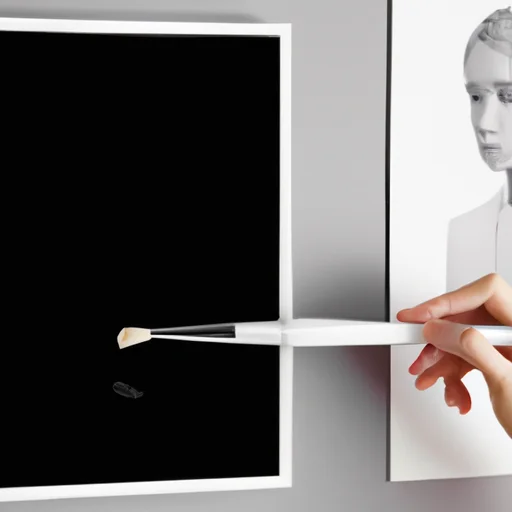Imagine wanting to transform a room from dark and moody to bright and airy, but you’re faced with the daunting task of covering up black walls with a lighter shade. Here’s the burning question on everyone’s mind: can you paint white over black? In this article, we explore the possibilities and limitations of this color transformation, providing you with the information you need to achieve your desired interior makeover. From the necessary preparation to the suitable techniques and potential challenges, we’ve got you covered on this fascinating paint dilemma.

Can You Paint White Over Black?
Table of Contents
Preparation
Clean the surface
Before starting any painting project, it’s essential to ensure that the surface is clean. Remove any dirt, dust, or grease from the surface using a mild detergent and water. Scrub the surface gently using a sponge or soft cloth. Once cleaned, rinse off any residue thoroughly and allow the surface to dry completely.
Sand the black paint
After cleaning the surface, it’s important to sand the black paint to create a smoother and rougher surface, allowing the new coat of paint to adhere better. Use a medium-grit sandpaper and sand the entire surface in a circular motion. Be sure to remove any loose paint flakes or rough spots. After sanding, wipe away any dust using a damp cloth.
Apply primer
Priming the surface is crucial, especially when painting white over black. The primer acts as a barrier between the black paint and the new white paint, preventing any bleed-through or discoloration. Choose a high-quality primer that is specifically designed for the type of surface you are painting. Apply the primer evenly using a brush or roller, following the manufacturer’s instructions. Allow the primer to dry completely before proceeding to the next step.
Choosing the right paint
Consider the type of paint
When selecting the paint for painting white over black, consider the different types available. Latex or acrylic paints are often the preferred choice for indoor applications because they have low levels of volatile organic compounds (VOCs) and are easier to clean up. Oil-based paints, on the other hand, are more durable and better suited for high-traffic areas or outdoor use. Consider the specific requirements of your project before choosing the type of paint.
Select the right color
While the goal is to paint white over black, it’s important to choose the right shade of white. White paints come in various undertones, such as warm, cool, or neutral. Consider the existing colors in the room or the desired aesthetic and choose a white paint that complements them. It’s also wise to test the paint on a small inconspicuous area before committing to the entire surface.
Opt for high-quality paint
Investing in high-quality paint is crucial, as it can significantly impact the final results and the durability of the painted surface. High-quality paints provide better coverage, smoother finishes, and superior color retention. They also tend to be more resistant to scuffs and stains. Look for reputable paint brands and read reviews to ensure you choose a paint that meets your needs and expectations.
Applying the paint
Use a roller or brush
Deciding between a roller or brush depends on the size and texture of the surface being painted. For larger, smoother areas, a roller can provide faster coverage. Use a roller with a nap appropriate for the texture of the surface, such as a short nap for smooth surfaces and a longer nap for textured surfaces. A brush, on the other hand, allows for more control and precision, making it suitable for edges, corners, and smaller areas. Use long, even strokes when applying the paint to achieve a smooth and consistent finish.
Apply multiple coats
When painting white over black, multiple coats are often necessary for the best results. Black paint tends to be more opaque, making it challenging to achieve full coverage with just one coat of white paint. Allow each coat of paint to dry completely before applying the next. After the first coat, assess the coverage and apply additional coats as needed to achieve the desired white finish. Be patient and take your time to ensure each coat dries evenly.
Allow proper drying time
Proper drying time is crucial to avoid smudges, streaks, or damage to the painted surface. Follow the manufacturer’s instructions regarding drying times for the specific type of paint you are using. It’s essential to wait until the paint is fully dry before placing any objects on or near the painted surface to prevent any imperfections or damage.
Dealing with coverage issues
Use a tinted primer
If you are experiencing issues with coverage when painting white over black, consider using a tinted primer. Tinted primers are specifically formulated to enhance the hiding power and coverage of the topcoat paint. By choosing a tinted primer that matches the color you intend to paint, it can help minimize the number of topcoat paint coats required to achieve full coverage.
Apply a paint conditioner
In some cases, the black paint may be quite difficult to cover, even with multiple coats of white paint. Adding a paint conditioner to the paint can help make it more workable and improve its hiding qualities. Paint conditioners can be mixed into the paint according to the manufacturer’s instructions and can help reduce brush strokes, increase adhesion, and improve coverage.
Consider using a thicker paint
If coverage issues persist, consider using a thicker paint specifically designed for better hiding properties. Some paints are formulated with higher levels of opaque pigments, which can provide better coverage even when painting over dark colors. Thicker paints cover more effectively and can save time and effort by requiring fewer coats to achieve the desired white color.

Covering textured surfaces
Fill in the texture
When dealing with textured surfaces, it’s important to address the texture before painting. Use a joint compound or spackling paste to fill in any deep grooves, cracks, or uneven areas. Apply the compound with a putty knife, ensuring it is spread evenly and smoothed out. Allow the compound to dry completely before moving on to the next step.
Sand the surface
Once the compound is dry, sand the surface using a fine-grit sandpaper. This step helps to create a smoother and more even surface, ensuring better adhesion of the primer and paint. Sanding also helps to remove any excess compound and create a seamless finish. After sanding, wipe away any dust using a damp cloth.
Apply a coat of primer
After sanding, apply a coat of primer to the textured surface. The primer will help to seal the surface and create a uniform base for the final paint coat. Use a brush or roller, depending on the size and texture of the surface, and follow the manufacturer’s instructions for the specific primer being used. The primer should be evenly applied, taking care to cover all areas, including the textured portions of the surface.
Addressing durability concerns
Consider using a bonding primer
If durability is a concern when painting white over black, using a bonding primer can help improve adhesion and ensure a longer-lasting finish. Bonding primers are specifically formulated to adhere to difficult surfaces, including glossy or slick ones. They create a strong bond between the paint and the surface, enhancing the overall durability and lifespan of the painted surface.
Apply a sealant or topcoat
To further enhance the durability of the painted surface, consider applying a sealant or topcoat. A clear sealant or topcoat can protect the paint from scratches, stains, or fading. Select a product that is compatible with the type of paint used and follow the manufacturer’s instructions for application. Applying a sealant or topcoat can prolong the life of the paint job and make it easier to clean and maintain.
Utilize a heat-resistant paint
If the painted surface is exposed to high temperatures or heat sources, such as near fireplaces or radiators, consider using a heat-resistant paint. Heat-resistant paints are designed to withstand elevated temperatures without discoloring or peeling. Ensure that the paint you choose is suitable for the specific temperature range it will be exposed to for optimal durability and performance.

Ensuring an even finish
Use long, even strokes
To achieve a smooth and even finish when painting white over black, use long, even strokes. Whether using a brush or a roller, try to maintain a consistent pressure and avoid stopping and starting in the middle of a stroke. This technique helps to minimize any visible brush marks or roller lines and results in a more professional-looking finish.
Work in sections
To maintain control and achieve even coverage, work in small sections when applying the paint. Start in one corner of the surface and gradually work your way across, applying the paint evenly as you go. By working in sections, you can ensure that the paint stays wet and blends well, avoiding any visible brush or roller marks.
Apply additional coats if necessary
After the first coat of paint has dried, assess the coverage and overall finish. If any areas appear uneven or the black color is still visible, apply additional coats as necessary. Multiple coats are often required when painting white over black to ensure full coverage and a uniform appearance. Allow each coat to dry fully before applying the next.
Drying and curing
Allow sufficient drying time
Proper drying time is essential for a successful paint job. Follow the manufacturer’s instructions regarding drying times for the specific type of paint used. Factors such as humidity, temperature, and ventilation can affect drying times, so it’s important to allow sufficient time to ensure the paint is fully dry before considering the project complete. Rushing the drying process can result in imperfections or damage to the painted surface.
Avoid excessive moisture or heat
During the drying process, it’s crucial to avoid exposing the painted surface to excessive moisture or heat. Moisture can interfere with the drying process and cause the paint to bubble or peel, while heat can accelerate drying and potentially affect the finish. Ensure proper ventilation in the area and avoid placing objects or covering the painted surface until it has fully dried and cured.
Follow manufacturer recommendations
Different paints may have specific recommendations for drying and curing times. To ensure the best results, always follow the manufacturer’s instructions provided on the paint can or packaging. These guidelines are tailored to the specific formulation of the paint and can help you achieve optimal drying and curing results, ensuring a long-lasting and durable finish.

Maintenance and care
Clean gently with mild soap and water
Once the painted surface is dry and cured, regular maintenance and care are necessary to keep it looking its best. To clean the painted surface, use a soft cloth or sponge dampened with mild soap and water. Avoid using harsh chemicals or abrasive cleaners, as they can damage the paint. Gently wipe the surface clean and rinse with clean water. Dry the surface thoroughly to prevent any water spots or streaks.
Avoid abrasive cleaning tools
When cleaning painted surfaces, it’s important to avoid using abrasive cleaning tools such as scrub brushes or rough sponges. These can scratch or wear away the paint, compromising its finish and longevity. Opt for softer cleaning tools and gentle techniques to maintain the integrity of the paint job.
Monitor for any signs of damage
Regularly inspect the painted surface for any signs of damage, such as chipping, peeling, or discoloration. If any issues are detected, address them promptly to prevent further damage and maintain the appearance of the painted surface. Touch up any minor imperfections with extra coats of paint, and consider consulting a professional if the damage is more severe.
Considering alternatives
Consider using a black primer
While painting white over black is the goal, using a black primer as a base coat can help achieve better coverage and reduce the number of topcoat paint coats required. Black primer acts as a color blocker and provides a solid foundation for the white paint, enhancing its ability to cover the black color effectively. Consider testing a black primer on a small area to determine if it improves the paint’s coverage.
Explore other colors or finishes
While painting white over black may be the specific goal, it’s worth considering alternative colors or finishes for your project. Depending on the desired aesthetic and the existing color scheme, other colors, such as lighter shades of gray or pastels, can be equally appealing and provide a fresh look. Additionally, experimenting with different finishes, such as matte or satin, can add depth and visual interest to the painted surface.
Consult a professional for advice
If you’re unsure about the best approach or want expert advice on painting white over black, it can be beneficial to consult a professional painter. They can assess the surface, provide guidance on paint selection, and offer additional techniques or solutions based on their experience. Professional painters also have the knowledge and tools to achieve the best possible outcome for your project.


